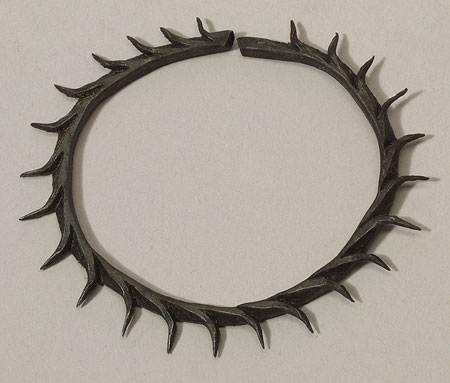Accession Number:
1936.10.20
Country:
Sudan
Region:
[Southern Sudan]
Cultural Group:
Nuer
Date Made:
By 1936
Materials:
Iron Metal
Process:
Forged (Metal) , Hammered
Dimensions:
L = 85.8 mm; W = 77.5 mm; Th = 3 mm [RTS 4/3/2004]
Weight:
19.5 g
Other Owners:
This object was probably collected in 1935 or 1936, when Evans-Pritchard held a research fellowship from the Leverhulme Trust (see E.E. Evans-Pritchard, 1940, The Nuer) [RTS 28/9/2004].
Field Collector:
Edward Evan Evans-Pritchard
PRM Source:
Edward Evan Evans-Pritchard
Acquired:
Donated 1936
Collected Date:
1935 - 1936
Description:
Armlet made from a single piece of iron with square to rectangular section hammered and bent into a loop, the ends 1 mm apart and almost touching.
Each end has been cut at an angle.
The upper surface has been worked with a chisel to form 24 long, sharp pointed spikes around its outer edge; each of these has been pulled away from the surface and bent into a slight arc that is angled downwards.
The inner surface which rests against the skin and the underside are both flat.
The object is complete and intact.
There is some kind of yellowish, possibly resinous material visible at the base of some of the barbs; it is not known if these are poisoned, although nothing is evident on the sharp tips.
The length across the armlet is 85.8 mm with spikes, and 71.8 mm without, while the width across it is 77.5 mm with spikes, and 64.5 mm without.
The width of the bar from which the armlet has been made is 3.7 mm, and its thickness 3 mm; it weighs 19.5 grams.
The metal is currently a silvery gray colour (Pantone 422C).
This object was collected by Edward Evan Evans-Pritchard when he held a research fellowship from the Leverhulme Trust (see E.E. Evans-Pritchard, 1940, The Nuer ), either during May to July 1935, when he worked amongst the Nuer Lou and Eastern Jikany, or from October to November 1936, when he was working amongst the Karlual section of the Nuer Leek, in Western Nuerland (pers. comm. Chris Morton 2004).
This object was worn around the wrist by boys when fighting or wrestling (E.E. Evans-Pritchard, 1940, The Nuer, p. 151), but in other groups they could be associated with men (the Lotuko), or women, who used them for both fighting and dance (the Moru) (see C. Spring, 1993, African Arms and Armour, p. 116). Lindblom has suggested that this type of fighting bracelet developed out of metal arm rings, and can be found among a number of African groups, including the Nuer, Dinka, Shilluk, Jibbeh, Bongo, Jur, Acholi, Madi, Latuka, Irenga, Jibbeh [= Murle], Abukaya and Mittu. He illustrates an example similar to this one, said to come from the Mbum, in Cameroon (K.G. Lindblom, 1927, ‘Fighting-bracelets and Kindred Weapons in Africa’, Smärre Meddelanden, p. 7 and fig. 6).
For other Nuer fighting bracelets in the Pitt Rivers collection, see 1931.66.34-35 and 1936.10.13-20.
Evans-Pritchard, writing in 1940, commented on the scarcity of iron amongst the Nuer and the high value consequently placed on objects made from it: 'Nuer have always been poor in iron objects ... Iron bells ... are rare and highly prized even at the present time, and in the old days iron rings and bracelets were important pieces of property' (E.E. Evans-Pritchard, 1940, The Nuer, p. 86).
Currently on display in the Upper Gallery, case 75A, display number 20.
Rachael Sparks 18/9/2005.
This object was collected by Edward Evan Evans-Pritchard when he held a research fellowship from the Leverhulme Trust (see E.E. Evans-Pritchard, 1940, The Nuer ), either during May to July 1935, when he worked amongst the Nuer Lou and Eastern Jikany, or from October to November 1936, when he was working amongst the Karlual section of the Nuer Leek, in Western Nuerland (pers. comm. Chris Morton 2004).
This object was worn around the wrist by boys when fighting or wrestling (E.E. Evans-Pritchard, 1940, The Nuer, p. 151), but in other groups they could be associated with men (the Lotuko), or women, who used them for both fighting and dance (the Moru) (see C. Spring, 1993, African Arms and Armour, p. 116). Lindblom has suggested that this type of fighting bracelet developed out of metal arm rings, and can be found among a number of African groups, including the Nuer, Dinka, Shilluk, Jibbeh, Bongo, Jur, Acholi, Madi, Latuka, Irenga, Jibbeh [= Murle], Abukaya and Mittu. He illustrates an example similar to this one, said to come from the Mbum, in Cameroon (K.G. Lindblom, 1927, ‘Fighting-bracelets and Kindred Weapons in Africa’, Smärre Meddelanden, p. 7 and fig. 6).
For other Nuer fighting bracelets in the Pitt Rivers collection, see 1931.66.34-35 and 1936.10.13-20.
Evans-Pritchard, writing in 1940, commented on the scarcity of iron amongst the Nuer and the high value consequently placed on objects made from it: 'Nuer have always been poor in iron objects ... Iron bells ... are rare and highly prized even at the present time, and in the old days iron rings and bracelets were important pieces of property' (E.E. Evans-Pritchard, 1940, The Nuer, p. 86).
Currently on display in the Upper Gallery, case 75A, display number 20.
Rachael Sparks 18/9/2005.
Primary Documentation:
Accession Book Entry
[p.
410] - 1936 [insert] 10 [end insert] E.
EVANS-PRITCHARD, M.A., Exeter College, Oxford.
- Specimens collected by himself in the EASTERN SUDAN, while travelling with a Grant from the
Rockefeller
Leverhulme Trustees, viz: [insert] 13-20 [end insert] - [One of] 8 Iron armlets, with the outer margins chiselled to form barbs, used in wrestling-fights.
NUER.
Card Catalogue Entry - There is no further information on the tribes catalogue card [RTS 23/7/2004].
Card Catalogue Entry - There is no further information on the tribes catalogue card [RTS 23/7/2004].



